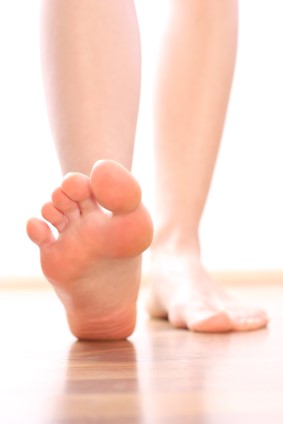Kind regards,


Our feet are often the part of our bodies that we ignore and take for granted. However, if we do experience foot pain it can have a hugely negative impact on our daily activity and subsequently, our mental health too.
Each foot is made up of 26 bones connected by tendons, ligaments & muscles. The thick connective tissue sole of the foot (the Plantar Fascia) acts as a vital shock-absorber enabling us to absorb impact and traverse uneven terrain.
There is a very fine balance of function within the foot. When we walk or move, there is impact on heel strike with force then travelling through to the front of the foot and the toes pushing off the ground to propel the body forwards.
Pain may cause us to shorten our stride, weight-bear differently or to limp. This in turn will alter how we use our knees, hips and spine to function and may cause muscle fatigue, ligament or tendon overuse strain and back pain.

There are a multitude of problems that may affect the foot and ankle but here are the most common.
Sprained Ankle: losing one’s balance or just stumbling often results in a twisted ankle. Most common is when the foot folds inwards and we sprain/overstretch the ligaments on the outside of the ankle. However, it is also possible to sprain the inside ligaments falling the other way. A severe ankle sprain may take up to 12 weeks to recover and can be as debilitating as a fracture.
As Osteopaths, we have the tools to help you recover from a sprained ankle. Never hesitate to get in touch if you are unfortunate enough to have this injury.
Plantar Fasciitis: this is pain and inflammation of the connective tissue that forms the thick sole of the foot. Pain can be under the heel or under the arch of the foot. The Plantar Fascia connects to the Achilles Tendon at the ankle and this connection can make walking extremely difficult when there is inflammation and pain.
It can take an extended time to heal due to how the area is supplied with blood and lymphatics and good physical therapy is essential. We see this problem commonly and as your Osteopaths we can help you with the return to health. In severe cases, you may need additional onward referral for a boot to immobilise the foot or for steroid injections to reduce inflammation.
Pain in the Ball of the Foot: pain in the ball of the foot may have different causes. It might be due to Morton’s Neuroma (where the nerves between the toes may thicken and cause pain) or it might be due to the natural arches of the foot collapsing slightly with age or poor footwear.
Your Osteopath will be able to advise on the cause of the pain and direct you to find the way to help. This may involve onward referral for steroid injection or insoles to improve foot function. Rehabilitation exercises for health of the foot arch and for good gait function are often prescribed.
Achilles Tendonitis: this is pain and swelling of the Achilles tendon which attaches the calf muscles to the heel. Overuse of the tendons alongside tight calf muscles are a factor.
Your Osteopath may use ultrasound therapy and massage techniques to ease the tension and pain. Rehabilitation exercises are often prescribed. You may also be prescribed orthotic products to help the healing process.

Get A Diagnosis – see your Osteopath or other musculoskeletal health therapist to diagnose the cause of the pain. This is the most important step as this will determine what you need to do next to aid your recovery.
The foot is very complex so your pain could have multiple causes and management is key.
Pain Management – getting your pain under control is really important as foot pain makes one very sedentary and this can be very distressing.
Pain in the foot and ankle often involves inflammation and, where appropriate, you may be advised to take Nonsteroidal anti-inflammatory medications or to have onward referral for injections.
Cold Therapy and even Orthotic supports inside your shoes may be vital for reduction of pain. Managing the pain appropriately will enable you to function as normally as possible whilst your body heals.
Rest with Gentle Movement – foot pain is hard to manage. Rest is vital but movement is also needed to keep good circulation to the feet which in turn aids healing. Depending on your diagnosis, your Osteopath or therapist will advise the best approach.
Do your Advised Exercises – listen to your Osteopath or musculoskeletal health therapist and follow their advice.
Foot and Ankle pain may need stretch exercises to do at home and you may need supportive taping to help reduce load on joints and muscles. Your diagnosis will determine which exercises are prescribed.
Should you be advised to use orthotic help within your shoes, your Osteopath will help you through this process to get the appropriate support.
If you need our help and would like to book an appointment, Please Call: 0208 977 6396
If you have aches and pains, don’t wait, just call the clinic and come in and we will be able to diagnose the problem.
You can email info@osteopathuk.co.uk or call 02089776396
| Click the link for our website: http://www.osteopathuk.co.uk/ |

Please do not hesitate to get in touch with us for any reason, we are here to help and welcome any feedback. Click here for more information.